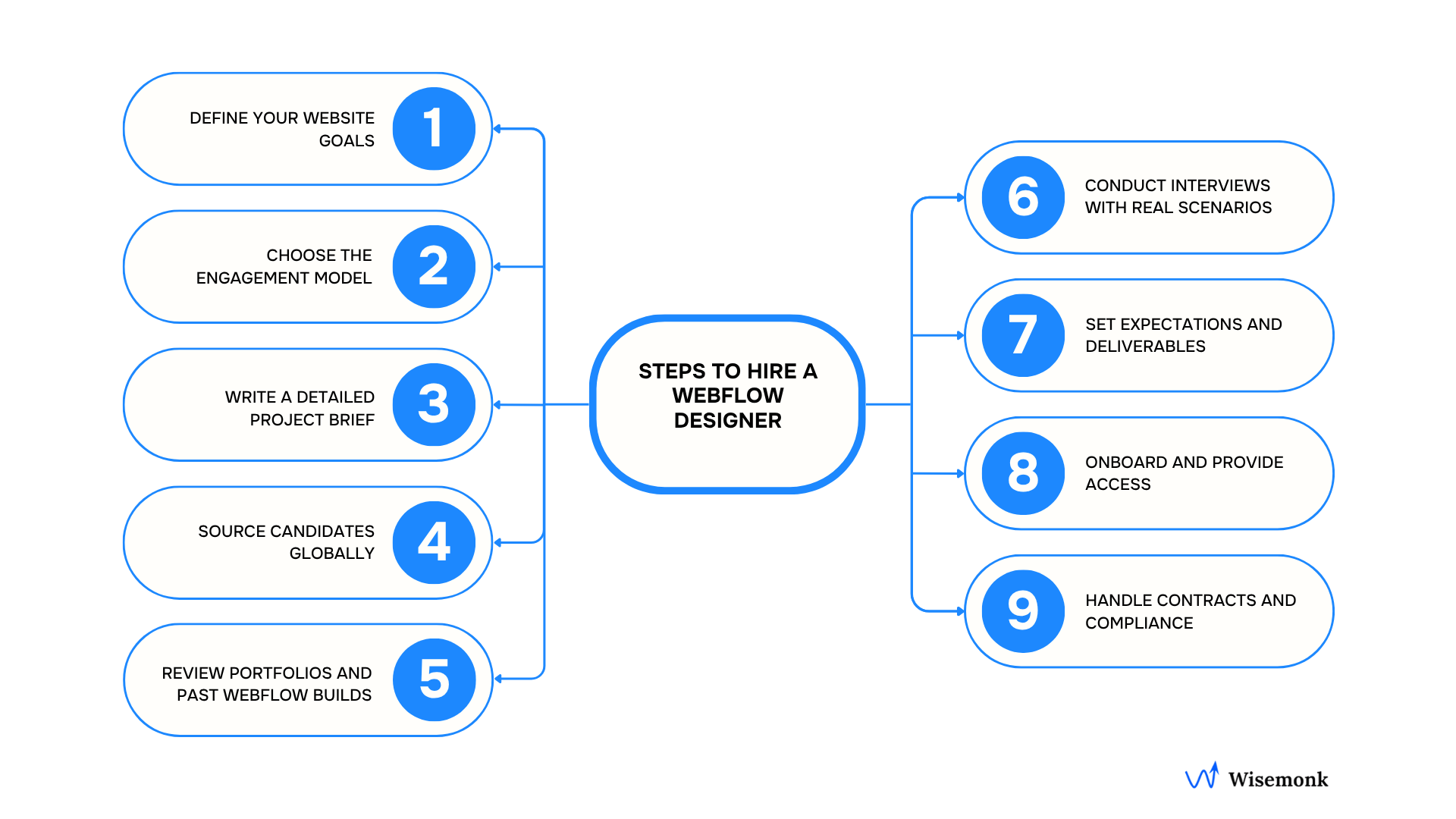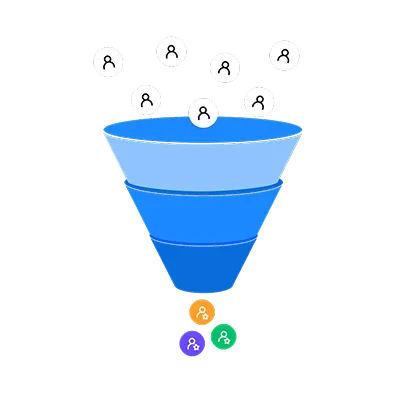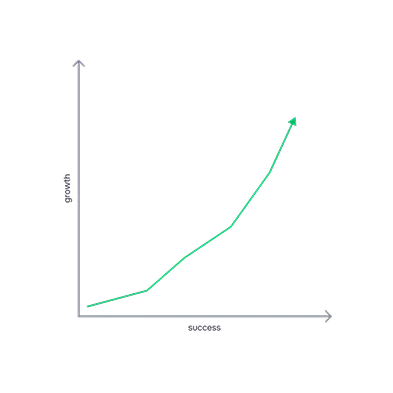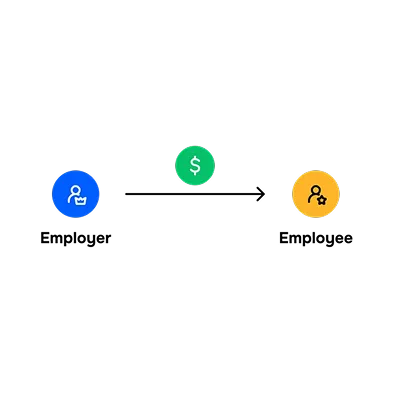If you’re thinking about hiring a Webflow designer but aren’t sure where to start, this guide is for you. We’ve put together a practical, step-by-step resource to help global companies understand how to find, evaluate, and hire the right Webflow expert. From defining your project goals to managing performance after launch, this guide will help you make confident, informed decisions that lead to a fast, beautiful, and conversion-focused website.
Why hire a Webflow designer?[toc=Why Hire Designer]
If your website looks outdated, loads slowly, or doesn’t convert visitors into leads, it’s probably time to hire a Webflow designer.
Webflow makes it possible to design websites without code, but truly professional results still require skilled Webflow designers who understand responsive design, custom interactions, and SEO optimization. DIY sites often fall short; they can look inconsistent, break on mobile, or miss important features like accessibility and performance tracking.
A Webflow designer bridges that gap. They create custom websites that are fast, scalable, and visually aligned with your brand identity. With expertise in responsive design tools, CMS capabilities, and advanced animations, they ensure your site not only looks great but also drives results.
For global companies, hiring a Webflow expert means more than just building a site; it’s about creating a digital experience that performs consistently across markets, devices, and languages. Experienced Webflow designers bring both creative and technical skills to elevate your business’s online presence.
What does a Webflow designer actually do?[toc=Key Responsibilites]
A Webflow designer is both a creative thinker and a technical problem-solver. They use the Webflow platform to create custom websites that look beautiful, perform well, and align perfectly with your business goals.
Here’s what a Webflow designer typically does:
- Designs and builds responsive websites that look and function flawlessly across desktop, tablet, and mobile devices.
- Develops using the Webflow platform to turn design mockups into fully functional websites without needing heavy coding.
- Sets up and manages Webflow CMS collections so your team can easily update blogs, products, or portfolio content.
- Implements custom animations and interactions that enhance user experience and keep visitors engaged.
- Optimizes SEO performance by structuring content correctly, improving site speed, and adding metadata for better rankings.
- Integrates APIs and third-party tools such as Zapier, Memberstack, or analytics platforms for added functionality.
- Collaborates with marketing, content, and brand teams to ensure the website supports business goals, messaging, and visual identity.
- Provides ongoing support and maintenance after launch to ensure your site stays secure, updated, and optimized.
It’s also important to understand the difference between a Webflow designer, a Webflow developer, and a traditional web designer.
- A Webflow designer focuses on design and functionality within Webflow, managing both layout and user experience.
- A Webflow developer adds more complex custom code or API integrations for advanced functionality.
- A traditional web designer may create layouts but often relies on developers to build the final site.
In short, a Webflow designer combines design creativity with technical capability to create responsive, conversion-focused, and visually appealing websites that bring your brand to life.
What skills should you look for in a Webflow designer?[toc=Essential Skills]
Hiring a Webflow designer isn’t just about finding someone who can make your website look good. You need a professional who can combine creativity, technical precision, and strategic thinking to build a site that performs, converts, and scales.
From our experience helping global companies hire skilled Webflow designers and developers, here’s what to look for:
Technical Skills
- Webflow expertise: Deep understanding of the Webflow platform, including CMS setup, custom layouts, and responsive design tools.
- UI/UX design: Ability to create user-friendly, visually appealing interfaces that match your brand and engage visitors.
- SEO optimization: Knowledge of on-page SEO, accessibility optimization, and site speed best practices.
- Custom animations and interactions: Experience creating dynamic visuals, hover effects, and transitions that enhance the user experience.
- API and tool integrations: Familiarity with Zapier, HubSpot, or analytics tools for automation and tracking.
- Web development basics: Understanding HTML, CSS, and custom code for advanced functionality.
- E-commerce and CMS capabilities: Skill in setting up online stores, product collections, and content-driven websites.
Design and Collaboration Skills
- Visual design sense: Strong grasp of typography, color balance, and layout composition.
- Brand alignment: Can translate brand guidelines into consistent, modern web experiences.
- Communication and teamwork: Works closely with marketing, content, and product teams to align the website with business goals.
- Project management: Keeps timelines, feedback cycles, and project scope under control from start to finish.
- Problem-solving mindset: Handles challenges like responsiveness, mobile optimization, and accessibility with confidence.
Bonus Skills for Global Projects
- Localization and multilingual experience: Builds websites that perform across languages and regions.
- Cross-platform testing: Ensures consistency across browsers, markets, and devices.
A great Webflow designer doesn’t just build pages; they craft digital experiences that reflect your brand and drive real results.
How to hire a Webflow designer?[toc=How to Hire]
Hiring a Webflow designer is about finding someone who can bring your website vision to life while ensuring it’s fast, responsive, and aligned with your brand goals.
Here’s a clear process to help you hire the right Webflow expert for your project:

Step 1: Define Your Website Goals
Start by identifying what you want to achieve. Are you building a new site, redesigning an existing one, or creating specialized landing pages? Defining the purpose helps you find designers with the right experience in conversion-focused or brand-heavy projects.
Step 2: Choose the Engagement Model
Decide whether you need a freelancer, a full-time Webflow designer, or an agency. Freelance Webflow designers are great for one-time projects, while full-time or remote Webflow developers are ideal for ongoing maintenance and growth. Global companies often partner with Wisemonk to hire remote Webflow professionals compliantly without worrying about cross-border contracts or payroll.
Step 3: Write a Detailed Project Brief
Outline your project scope, objectives, target audience, and visual preferences. Include examples of sites you like, required CMS capabilities, and must-have features like animations, e-commerce functionality, or SEO optimization.
Step 4: Source Candidates Globally
Search through platforms like the Webflow Experts Directory, Dribbble, Behance, or LinkedIn to find experienced Webflow designers. Review portfolios that include responsive websites, custom interactions, and clean layouts.
Step 5: Review Portfolios and Past Webflow Builds
Don’t just look at visuals; check how their previous projects performed. Test site speed, navigation, and mobile responsiveness. A strong Webflow portfolio should show creativity, technical skills, and design consistency.
Step 6: Conduct Interviews with Real Scenarios
Ask practical questions such as “How would you improve a site’s conversion rate?” or “What steps do you take to optimize for SEO?” This helps you understand their problem-solving skills and technical depth.
Step 7: Set Expectations and Deliverables
Agree on milestones, timelines, and review checkpoints. Define deliverables such as mockups, Webflow staging links, or CMS setup documentation.
Step 8: Onboard and Provide Access
Give your designer access to brand guidelines, content, and tools like Figma, Loom, or Notion for collaboration. Establish a simple feedback cycle to keep progress transparent.
Step 9: Handle Contracts and Compliance
When hiring internationally, managing payments, contracts, and tax compliance can get tricky. That’s where Wisemonk simplifies the process by managing onboarding, contracts, and payroll compliantly across borders, so you can focus on your project.
Hiring a Webflow designer becomes effortless when you approach it systematically. The right designer will not only build a stunning website but also ensure it performs flawlessly and reflects your brand perfectly.
How much does it cost to hire a Webflow designer?[toc=Cost to Hire]
The cost of hiring a Webflow designer depends on their experience, project complexity, and where they’re based. Simple landing pages may cost a few thousand dollars, while full-scale, CMS-driven websites with custom animations and integrations require a larger budget.
Here’s a general breakdown of what Webflow designers charge globally:
Key factors that affect pricing:
- Experience and skill level: Top Webflow experts with advanced capabilities, animations, and SEO experience often charge more.
- Project scope: Larger projects with CMS collections, e-commerce websites, or custom interactions take more time and cost more.
- Design complexity: Unique layouts, custom code, and animations increase both design time and development effort.
- Revisions and ongoing maintenance: Some designers include revisions and ongoing support; others charge separately.
- Location and hiring model: Remote Webflow developers from Asia or Eastern Europe often provide great value without compromising quality.
When comparing rates, focus on value over cost. The best Webflow designers don’t just create visually appealing websites; they build conversion-optimized, responsive websites that strengthen your business’s online presence.
How to manage and measure performance?[toc=Manage & Measure]
Hiring a Webflow designer is just the start; managing their work effectively ensures your website is delivered on time, performs well, and meets your business goals. A structured process helps you maintain design quality, streamline communication, and track results clearly.
From our experience helping global companies manage design and development teams, here’s how to evaluate and guide your Webflow designer:
1. Define clear deliverables
Start with a detailed scope of work. List all deliverables such as wireframes, mockups, final Webflow builds, CMS setup, and SEO optimization. Make sure both sides agree on milestones and timelines before the project begins.
2. Use the right collaboration tools
Feedback tools like Figma, Loom, and Webflow’s shareable preview links make it easy to review progress and give clear, actionable feedback. These tools reduce back-and-forth and help maintain design consistency.
3. Set performance metrics
Track measurable results once the website goes live. Common metrics include site speed, conversion rate, bounce rate, SEO performance, and mobile responsiveness. These show whether the website truly supports your goals.
4. Monitor responsiveness and accessibility
Ask your Webflow designer to test across devices and browsers. A skilled Webflow professional ensures accessibility optimization, fast load times, and consistent design across platforms.
5. Establish a feedback and review rhythm
Schedule weekly or bi-weekly check-ins to discuss project status, revisions, and next steps. Consistent communication keeps the project on track and reduces delays.
6. Evaluate post-launch performance
Once the project is complete, review site analytics and user engagement to gauge overall success. Discuss opportunities for updates, automation, or new features for future improvements.
When you manage your Webflow projects with clarity and structure, you not only ensure timely project completion but also create a website that delivers lasting results.
What mistakes should you avoid when hiring or managing a Webflow designer?[toc=Mistakes to Avoid]
Hiring a Webflow designer can be a game changer for your brand’s online presence, but only if you avoid the common mistakes that often lead to missed deadlines, poor design quality, or overspending.
From our experience helping global companies hire and manage Webflow professionals, here are the biggest pitfalls to steer clear of:
- Hiring based only on price: Choosing the cheapest option might save you money upfront but often results in poor performance, weak design structure, or websites that break easily. Focus on skill, portfolio quality, and client satisfaction over cost.
- Skipping live site reviews: Don’t just rely on screenshots. Always review live Webflow projects from their portfolio to check responsiveness, page load speed, and SEO setup.
- Providing unclear project requirements: Vague project briefs create confusion. Define your scope, goals, and design style clearly from the start, including key pages, CMS needs, and custom functionality.
- Ignoring mobile optimization: Many companies forget to test mobile versions, even though a majority of web traffic now comes from phones. Skilled Webflow designers ensure every site is responsive, fast, and user-friendly on all devices.
- Delayed feedback cycles: Slow communication leads to missed milestones and design inconsistencies. Schedule regular check-ins to keep progress smooth and revisions efficient.
- Overlooking contracts and ownership rights: Always have contracts that define ownership of design assets, custom code, and final files. When hiring globally, Wisemonk helps manage compliance, contracts, and intellectual property to protect your business.
Avoiding these common mistakes keeps your Webflow projects on track and ensures you get a high-performing, conversion-focused website that aligns perfectly with your business goals.
How can global companies hire and manage webflow designers easily?[toc=Hire & Manage Easily]
Hiring a Webflow designer globally isn’t just about finding talent; it’s about managing contracts, payments, and compliance while keeping projects on track and up to standard.
Remote collaboration across time zones is now the norm, but it brings headaches: tax laws, IP ownership, and payment delays. That’s where Employer of Record (EOR) and Contractor Management solutions make hiring simple and compliant.
From our experience helping global companies hire Webflow experts and skilled web developers, here’s how an EOR simplifies the process:
- Compliant contracts: Create legally sound agreements that define IP ownership, project scope, and confidentiality.
- Fast onboarding: Get your remote Webflow designers started quickly with secure access to Webflow accounts and collaboration tools.
- Localized payroll: Pay your designers in their local currency without worrying about exchange rates or tax deductions.
- Legal and tax compliance: Ensure all documentation, withholdings, and benefits align with each country’s labor laws.
- Centralized project visibility: Manage timelines, milestones, and feedback seamlessly through one system.
With Wisemonk, you can hire, pay, and manage top Webflow designers across the world without setting up local entities. We handle compliance, payroll, and contracts so your team can focus on designing, launching, and maintaining high-performing websites.
What should be on your hiring checklist?[toc=Hiring Checklist]
Before you start shortlisting candidates or reviewing portfolios, make sure you have a clear checklist in place. A structured approach ensures you hire the right Webflow designer for your goals and avoid delays or communication gaps during the project.
Here’s a simple checklist to guide you:
Webflow Designer Hiring Checklist
- Define your project goals and scope: Decide whether you’re building a new site, redesigning an old one, or creating landing pages. Clarify your design style, target audience, and must-have features.
- Write a detailed design brief: Outline objectives, required pages, animations, integrations, and CMS capabilities. Include examples of websites you like and your expectations for responsiveness and SEO optimization.
- Set your budget and timeline: Know your financial limits and project deadlines before you start searching for candidates. This helps filter designers who fit your requirements.
- Review portfolios and live projects: Look for experience in custom websites, responsive design, and Webflow development. Test their live Webflow projects for speed, functionality, and mobile optimization.
- Shortlist and interview top candidates: Ask practical questions about their workflow, project management tools, and how they handle revisions or client feedback.
- Finalize contracts and IP ownership: Ensure all contracts specify deliverables, ownership of design files, and post-launch responsibilities.
- Plan onboarding and collaboration: Provide access to brand assets, Webflow accounts, and project management tools. Set up weekly check-ins to track progress.
- Handle compliance and payments: When hiring remotely, make sure you’re compliant with local labor and tax laws. Wisemonk helps global companies manage contracts, payroll, and compliance for Webflow designers worldwide.
Having this checklist keeps your process organized, minimizes risks, and ensures your Webflow project runs smoothly from design to delivery.
Conclusion
Hiring a Webflow designer is one of the best investments you can make for your business’s online presence. The right designer doesn’t just create pages; they build custom, responsive, and high-performing websites that align with your brand and drive real results. Whether you’re hiring locally or globally, focus on clear communication, strong portfolios, and structured management. And if you want to simplify global hiring, Wisemonk can help you hire, pay, and manage top Webflow designers anywhere in the world quickly and compliantly.
Ready to hire webflow designers? Contact us today to discuss your hiring needs!







































